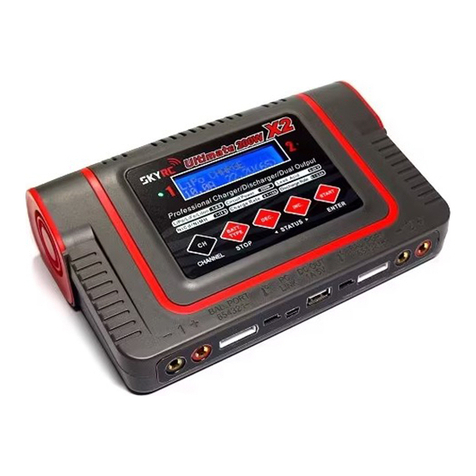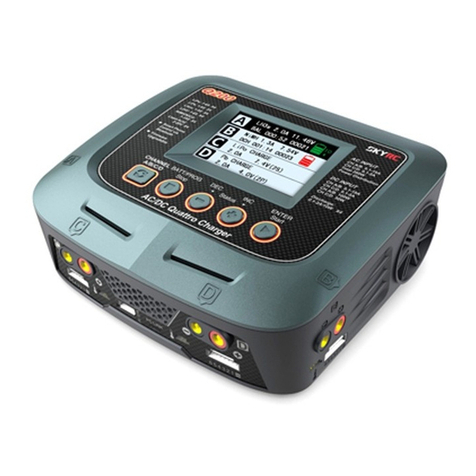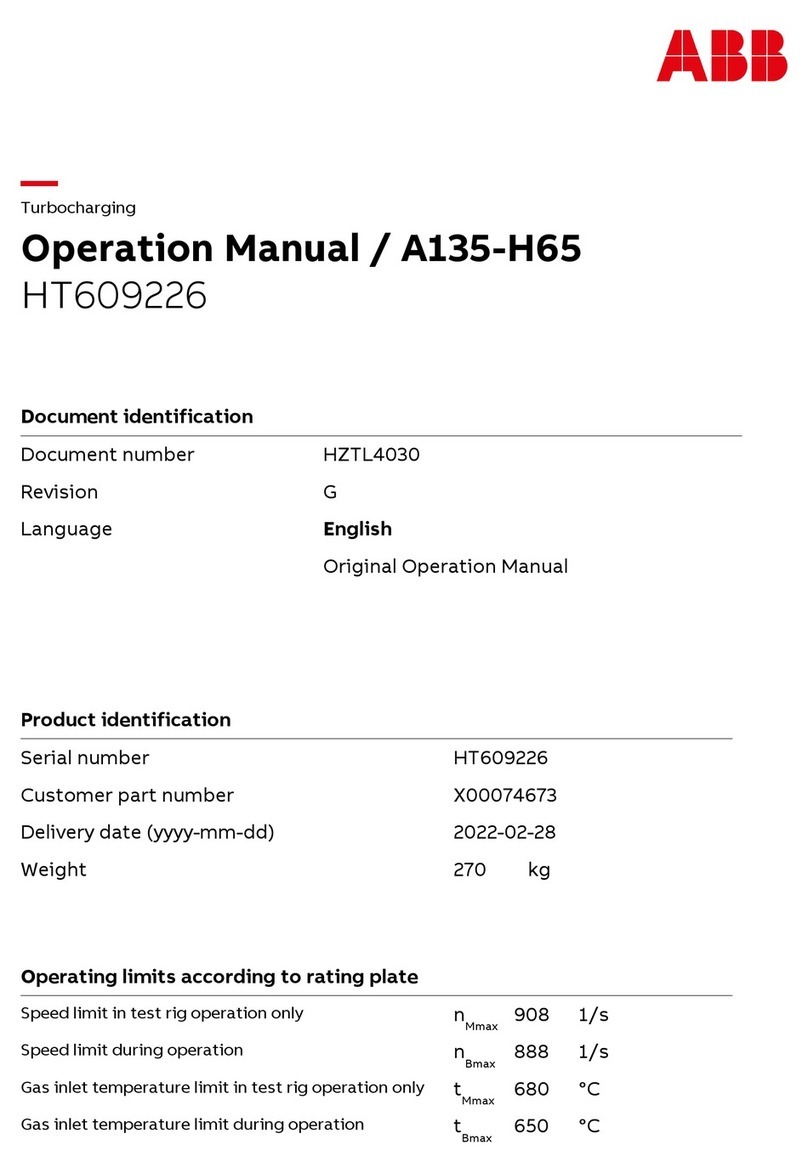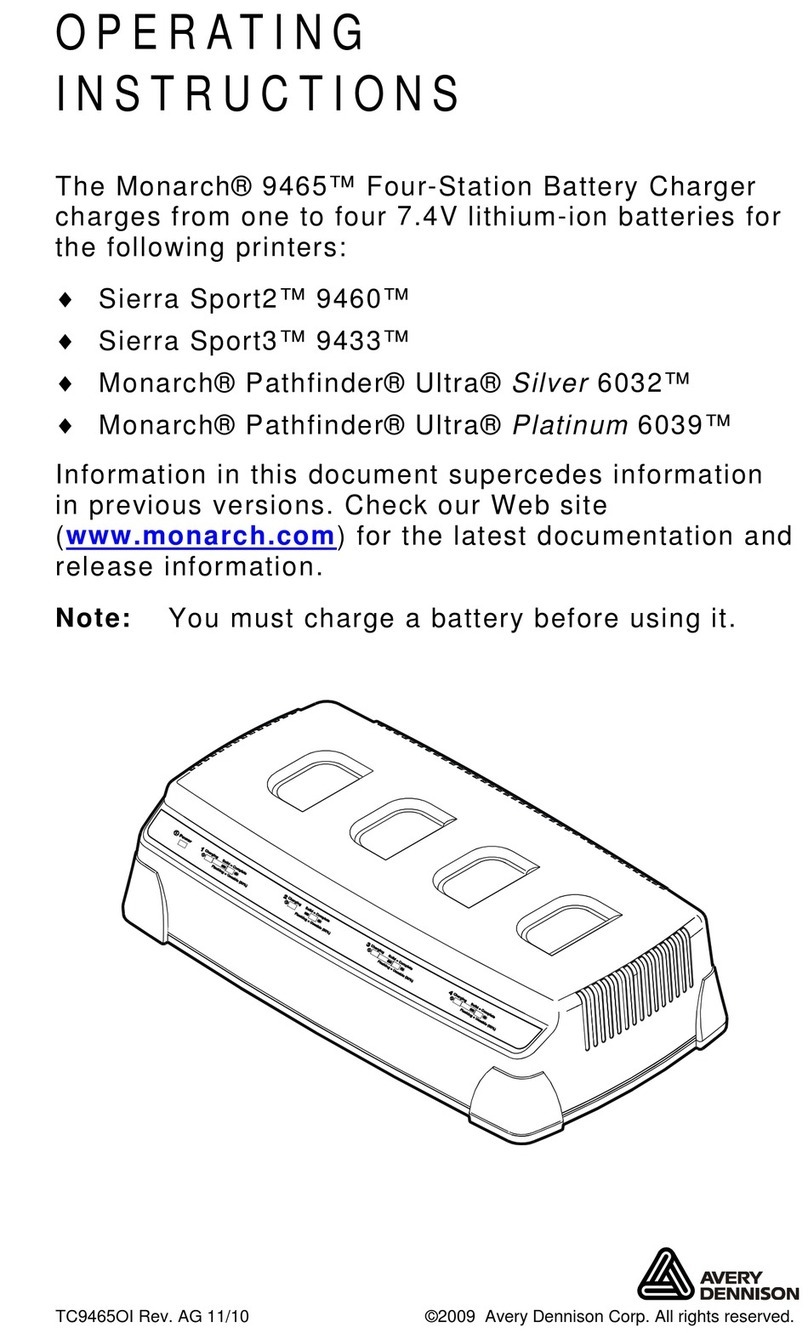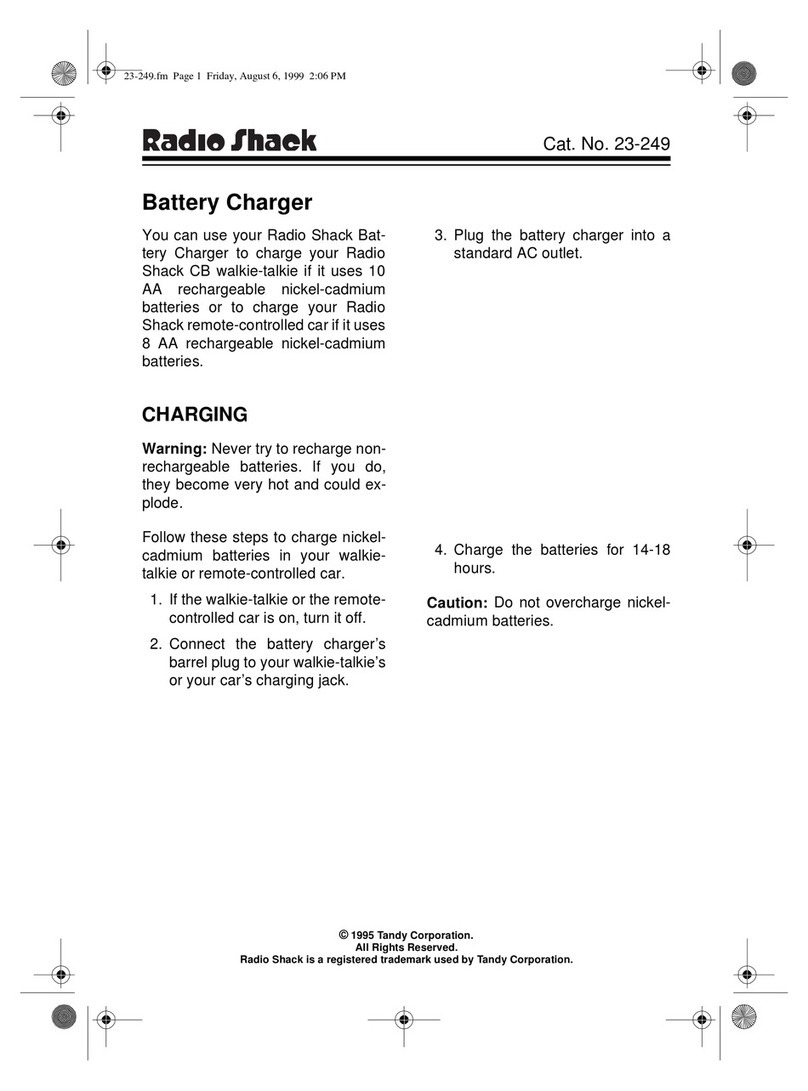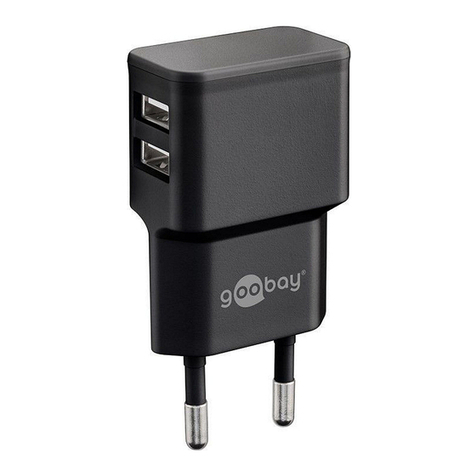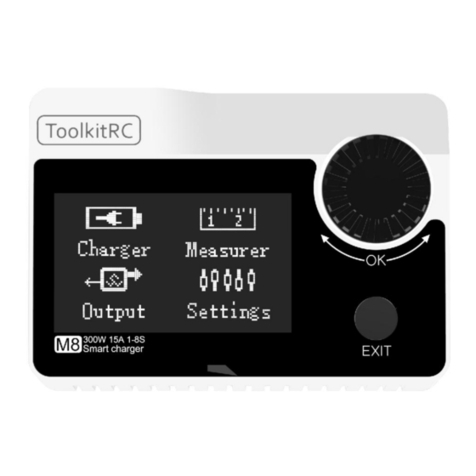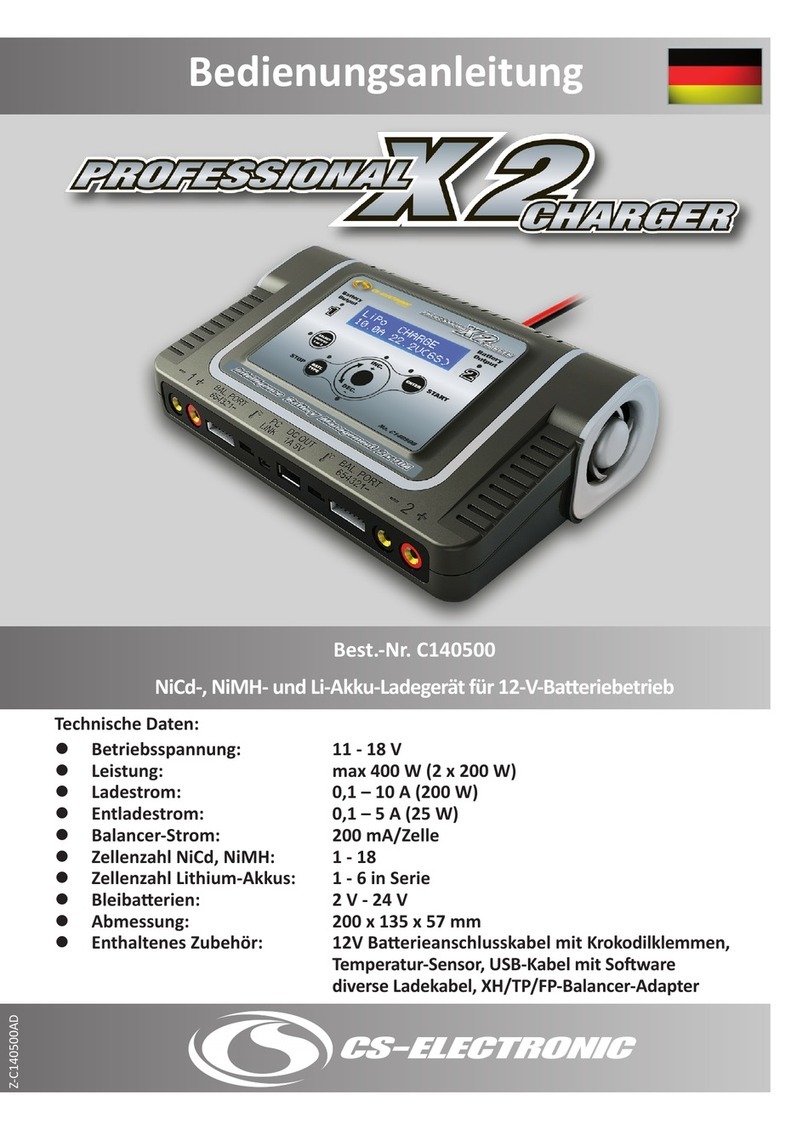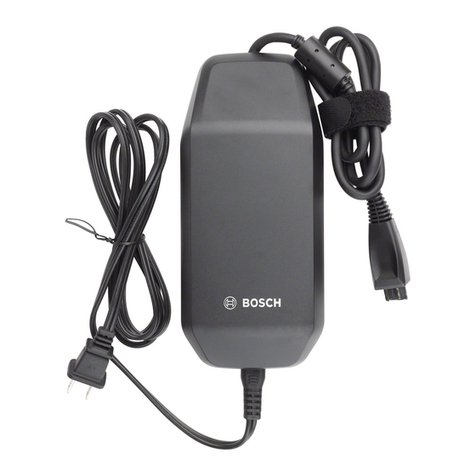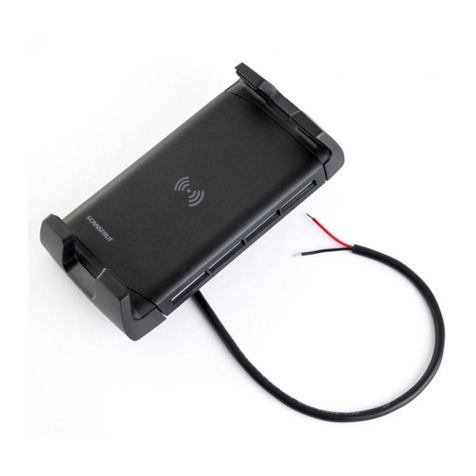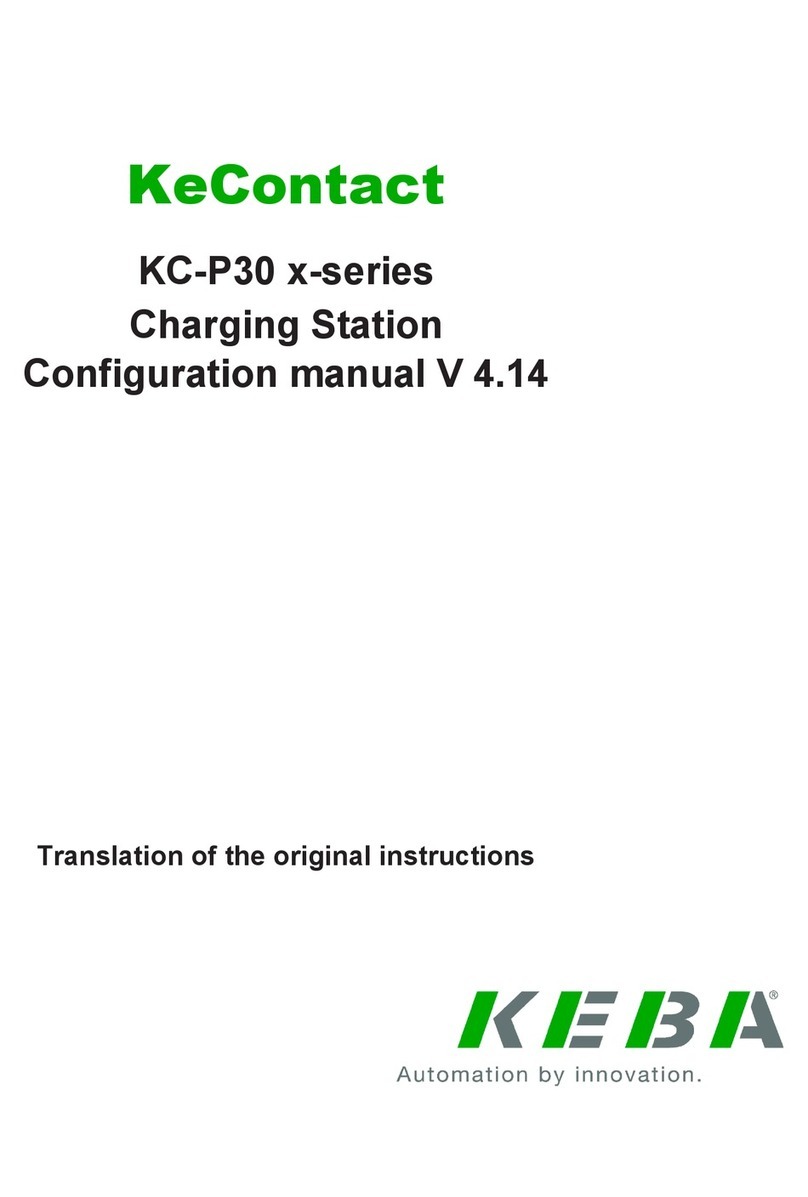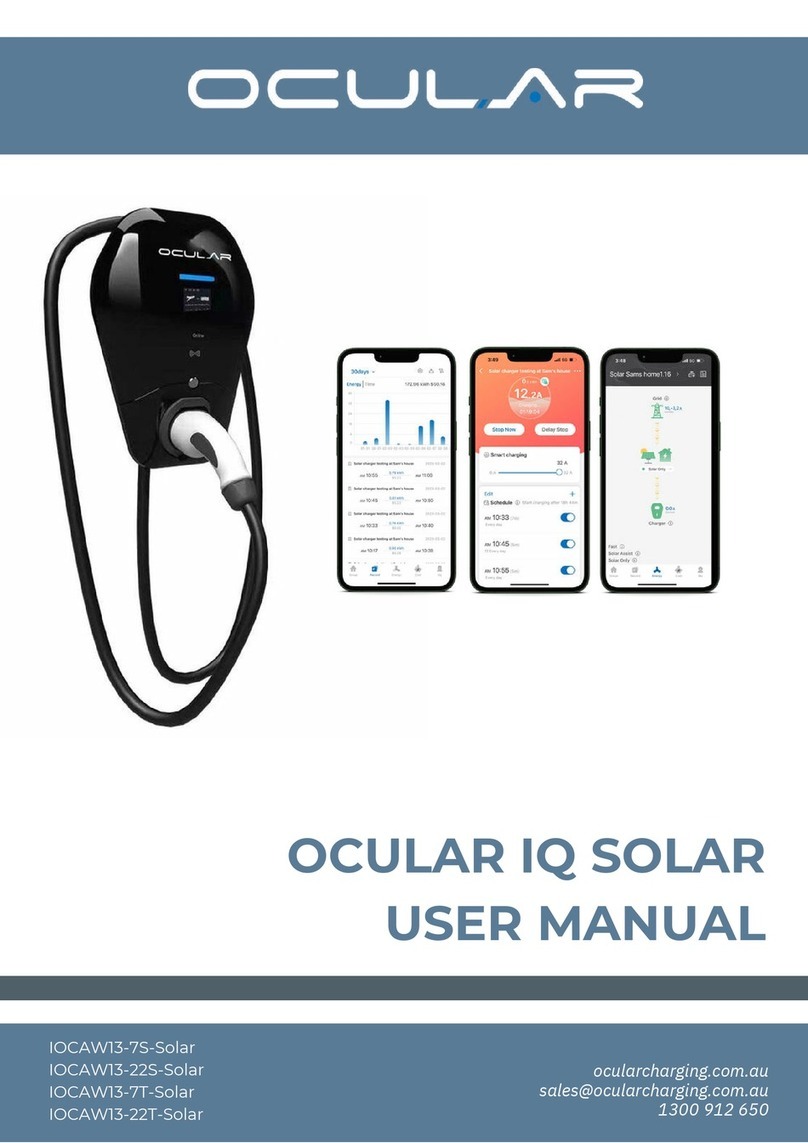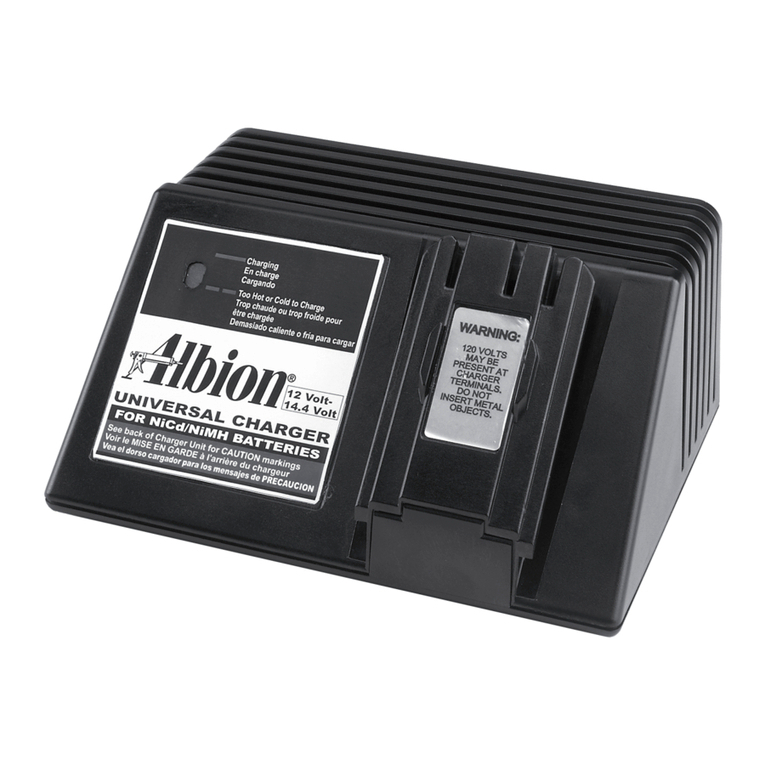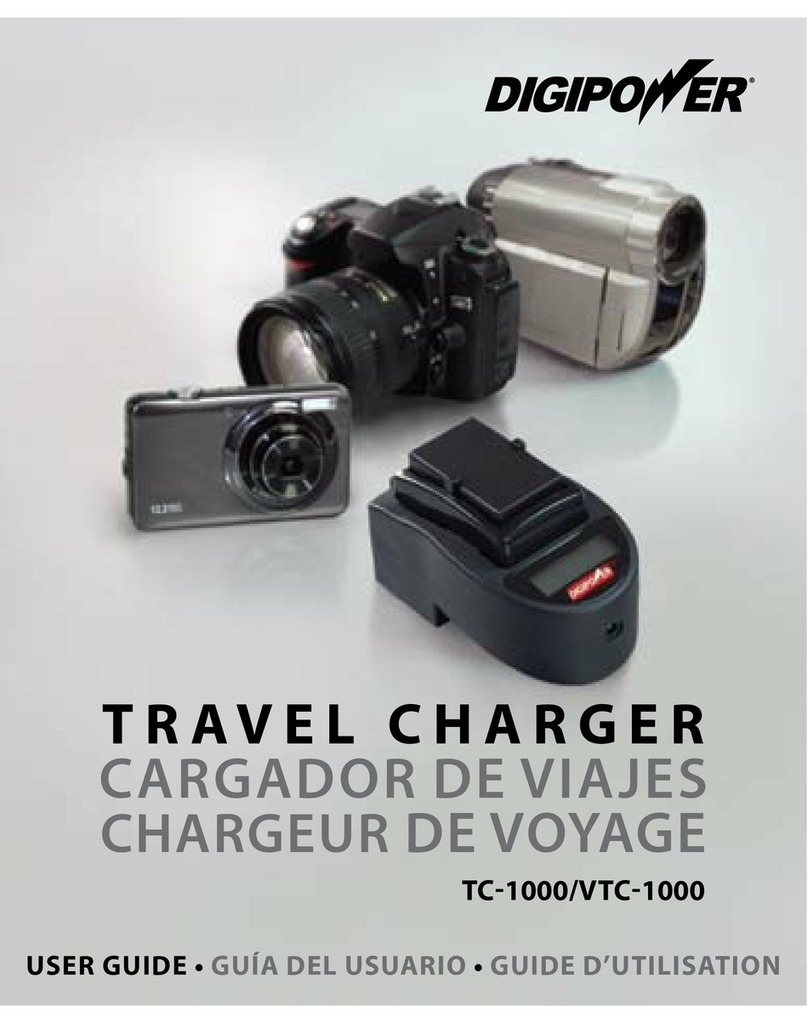Skyrc iMAX B6 mini User manual

C
www.skyrc.cn SkyRC Technology Co., Ltd.2009

TABLE OF CONTENTS
Introduction.........................................................................................................................01
Special features..................................................................................................................02
.................................................04
Warning and safety notes.....................................................................................................05
................................................................................................10
....................................................................................12
Charging of lithium battery....................................................................................................16
Balance charging of lithium battery........................................................................................17
.............................................................................................18
...........................................................................................19
...........................................20
.............................................................................................21
............................................................................................22
........................................23
....................................................................................................24
................................................................................................25
..........................................................................................................26
...............................................................................................................27
........................................................................................28
..................................................................................................29
Recommended accessories.......................................................................................31
Conformity declaration........................................................................................................32
................................................................................................33
Specifications......................................................................................................................34
...........................................................................................................34
Lithium polymer balance charge program connection diagram
Program flow chart...............
Fast charging of lithium battery
Storage control of lithium battery
Discharging of lithium battery.....................................................
Charging of NiCd/NiMHbattery
Discharge of NiCd/NiMH battery
Charge/discharge and discharge/charge cycle of NiCd/NiMH battery
Charging of the Pb battery
Discharging of the Pb battery
Storage data program
Load data program
Various information in the program
Warning and error message
Maximum circuit power chart
Warranty and service
Initial parameter setup (users set up)

INTRODUCTION
Introduction
Thank you forpurchasing the iMAX-B6Professional Balance Charger by iMAX. Thisproduct is a
rapid charger witha high performance microprocessor and specializedoperating software.
Please read thisentire operating manual completely and attentivelybefore using this product,
as it coversa wide range of information onoperating and safety. Or pleasedo use this product in
company with aspecialist!
LCD screen
16chr. 2lines
Balance lead sockets
JST-XH ports
Output charge lead
4mm banana plug
Start/enter
To resume
or start
the operation
Batt type/stop
To select
main program
To stop
the operation
Dec/inc
To selest
sub program
To alter
the value
Temperature
sensor port
01

SPECIAL FEATURES
Special features
Optimized operating software
IMAX-B6 features the so-called AUTO function that set the feeding current during the processof
charging or discharging. Especially for Lithium batteries, it can prevent the overcharging which
may lead to an explosion due to the user's fault. It can disconnect the circuit automatically and
alarm once detecting any malfunction. All the programs of this product were controlled through
two way linkage and communication, to achieve the maximum safety and minimize the trouble.
All the settingscan be configured by users!
Internal independent lithiumbattery balancer
IMAX-B6 employs an individual-cell-voltage balancer. It isn’t necessary to connect an external
balancer for balancecharging.
Balancing individual cellsbattery discharging
During the process of discharging, IMAX-B6 can monitor and balance each cell of the battery
individually. Error message will be indicated and the process will be ended automatically if the
voltage of anysingle one cell is abnormal.
Adaptable to varioustype of lithium battery
IMAX-B6 is adaptable to various types of Lithium batteries, such as Li-ion, LiPo and the new
LiFe series ofbatteries.
Fast and storagemode of lithium battery
Purposes to charge Lithium battery varies, ‘fast’ charge reduce the duration of charging,
whereas ‘store’ state can control the final voltage of your battery, so as to store for a long time
and protect usefultime of the battery.
PC based analysisuing USB Communication
IMAX-B6 offer PCbased program cananalysis the characteristic of the battery
via USB port.It shows a graph of voltage,current, capacity curves. It also shows the
individual voltage ofeach cell in the Lithium batterypack.
PC-LINK USB adaptorcan be purchased separately
02

Maximum safety
Delta-peak sensitivity: The automatic charge termination program based on the principle of the
Delta-peak voltage detection. When the battery's voltage exceeds the threshold, the process
will be terminatedautomatically.
SPECIAL FEATURES
Automatic charging currentlimit
You can set up the upper limit of the chargingcurrent when charging your NiCd or NiMH battery;
it is usefulfor the NiMH battery of lowimpedance and capacity in the 'AUTO'charging mode.
Capacity limit
The charging capacity is always calculated as the charging current multiplied by time. If the
charging capacity exceeds the limit, the process will be terminated automatically when you set
the maximum value.
Temperature threshold*
The battery’s internal chemical reaction will cause the temperature of the battery to rise. If the
temperature limit isreached, the process will be terminated.
* This function is available by connecting optional temperature probe, which is not included in
the package.
Processing time limit:
You can also limit the maximum processtime to avoid any possible defect.
Data store/load
The maximum five batteries’data can be stored for users’convenience. You can keep the data
pertaining to program setting of the battery of continuous charging or discharging. Users can
call out thesedata at any time without any special program setting.
Cyclic charging/discharging
1 to 5 cyclic and continuous process of charge>discharge or discharge>charge is operable for
battery refreshing andbalancing to stimulate the battery’s activity.
03

Failure to connect as shown in this diagram will damage this charger.
WARNING:
The main battery leads must be connected along with the balance lead connector as shown before charging
your battery ..
LITHIUM POLYMER BALANCE CHARGE PROGRAM
CONNECTION DIAGRAM
Lithium polymer balance charge program
connection diagram
This diagram showsthe correct way to connect yourbattery to the IMAX-B6 while charging in the
balance charge programmode only.
04

WARNING AND SAFETY NOTES
WARNING AND SAFETY NOTES
These warnings andsafety notes are particularly important.Please follow the instructions
for maximum safety;otherwise the charger and the battery can be damagedor at worst it
can cause afire.
Never leave the charger unattended when it is connected to its power supply. If any
malfunction is found, TERMINATE THE PROCESS AT ONCE and refer to the operation
manual.
Keep the chargerwell away fromdust, damp, rain,heat, direct sunshine and vibration.
Never drop it.
The allowable inputvoltage is 11~18V DC
This charger and the battery should be put on a heat-resistant, noninflammable and
nonconductive surface. Never place them on a car seat, carpet or similar. Keep all the
inflammable volatile materialsaway from operatingarea.
Make sure you know the specifications of the battery to be charged or discharged to
ensure it meets the requirements of this charger. If the program is set up incorrectly,
the battery and charger may be damaged .It can cause fire or explosion due to
overcharging. This warranty is not valid for any damage or subsequent damage
arising as a result of a misuse or failure to observe the procedures outlined in this
manual.
05

NiCd/NiMH
Voltage level:1.2V/cell
Allowable fastcharge current: 1C-2C (depends on the performance of cell)
Discharge voltage cutoff level: 0.85V/cell(NiCd), 1.0V/cell(NiMH)
Li-ion Voltagelevel: 3.6V/cell
Max. charge voltage:4.1V/cell
Allowable fastcharge current: 1C or less
Min. discharge voltagecut off level:2.5V/cell or higher
LiPo Voltagelevel: 3.7V/cell
Max. charge voltage:4.2V/cell
Allowable fastcharge current: 1C or less
Discharge voltage cutoff level: 3.0V/cellor higher
LiFe Voltagelevel: 3.3V/cell
Max. charge voltage:3.6V/cell
Allowable fastcharge current: 4C or less
Discharge voltage cutoff level: 2.0V/cellor higher
Pb Voltagelevel: 2.0V/cell
(Lead-acid) Max. chargevoltage: 2.46V/cell
Allowable fastcharge current: 0.4C or less
Discharge voltage cutoff level: 1.75V/cellor higher
WARNING AND SAFETY NOTES
06

WARNING AND SAFETY NOTES
To avoidshort circuit betweenthe charge lead always connect the charge cable to the
charger first, thenconnect the battery. Reverse thesequence when disconnecting.
Do not connectmore than one battery pack to this charger at any one time.
Never attempt tocharge or discharge the following types of batteries.
“A battery pack which consists of different types of cells (including
different manufacturers)
“A battery that is already fully charged or just slightly discharged.
“Non-rechargeable batteries (Explosionhazard).
“Batteries that require a different charge technique from NiCd, NiMh, LiPo
or Gel cell(Pb, Lead acid).
“A faulty or damaged battery.
“A battery fitted with an integral charge circuit or a protectioncircuit.
“Batteries installed in a device or which are electrically linked to other
components.
“Batteries that are not expressly stated by the manufacturer to be suitable
for the currentsthe charger delivers during the charge process.
07

WARNING AND SAFETY NOTES
Please bear inmind the following points before commencing charging:
“Did you select the appropriate program suitable for the type of battery you are
charging?
“Did you setup adequate current for charging or discharging?
“Have you checked the battery voltage? Lithium battery packs can be wired in
parallel and in series, i.e. a 2 cell pack can be 3.7V (in parallel) or 7.4V (in
series).
“Have you checked that all connections are firm and secure? Make sure there
are no intermittentcontacts at any point in the circuit.
Charging
During charge process, a specific quantity of electrical energy is fed into the battery. The
charge quantity is calculated by multiplying charge current by charge time. The maximum
permissible charge current varies depending on the battery type or its performance, and can
be found in the information by the battery manufacturer. Only batteries that are expressly
stated to be capable of quick-charge are allowed to be charged at rates higher than the
standard charge current.
Connect the battery to the terminal of the charger: red is positive and black is negative. Due to
the difference between resistance of cable and connector, the charger can not detect
resistance of the battery pack, the essential requirement for the charger to work properly is
that the charge lead should be of adequate conductor cross-section, and high quality
connectors which arenormally gold-plated should be fitted to both ends.
08

WARNING AND SAFETY NOTES
Always refer to the manual by the battery manufacturer pertaining to charging methods,
recommended charging current and charging time. Especially, the Lithium battery should be
charged according thecharging instruction provided by the manufacturer strictly.
Attention should bepaid to the connection of Lithium battery especially.
Do not attemptto disassemble the battery pack arbitrarily.
Please get highlighted that Lithium battery packs can be wired in parallel and in series. In the
parallel connection, the battery’s capacity is calculated by multiplying single battery’s
capacity by the number of cells with total voltage stay the same. The voltage’s imbalancemay
cause fire orexplosion .Lithium battery is recommended to charge in series.
Discharging
The main purpose of discharging is to clean residual capacity of the battery, or to reduce the
battery’ voltage to a defined level. The same attention should be paid to the discharging
process as charging. The final discharge voltage should be set up correctly to avoid deep-
discharging. Lithium batterycan not be discharged to lowerthan the minimum voltage, or it will
cause a rapid loss of capacity or a total failure. Generally, Lithium battery doesn’t need to be
discharged. Please pay attention to the minimum voltage of Lithium battery to protect the
battery.
Some rechargeable batteries have a memory effect. If they are partly used and recharged
before the whole charge is accomplished, they remember this and will only use that part of
their capacity next time. This is a ‘memory effect’ It is said that NiCd and NiMH batteries are
suffering from memoryeffect. NiCd hasmore memory effectthan NiMH.
Lithium batteries are recommended to be discharged partially rather than fully discharged.
Frequent full dischargingshould be avoided if possible. Instead,charge the battery more often
or use a battery of larger capacity.Full capacity cannot be reached until it has been subjected
to 10 or more charge cycles. The cyclic process of charge and discharge will optimize the
capacity of batterypack.
09

PROGRAM FLOW CHART
Program flow chart
Continue on next page!
10

PROGRAM FLOW CHART
Program flow chart
11

As default thischarger will be set to typicaluser settings when it is connected to DC 11~18V for
the first time.The screen displaysthe following information in sequence andthe user can change
the parameter oneach screen.
If you needto alter the parameter value inthe program, press Start/Enter key to makeit blink
then change thevalue with INC or DEC key. The value will be stored bypressing
Start/Enter key once.
LiFe
V.Type 3.3V
LiFe
V.Type 3.3V
LiFe
V.Type 3.3V
LiFe
V.Type 3.3V
INC
DEC INC
INCDEC
LiFe
V.Type 3.3V
LiFe
V.Type 3.3V
User setup startingscreen.
The screen displaysthe nominal voltage of Lithium battery. There arethree kinds
of Lithium battery:LiFe(3.3V), Lilo(3.6V) or LiPo(3.7V). This isvery important so
you have tocheck the battery carefully and setit up correctly. If itis different from
correct value thebattery may be exploded during chargeprocess.
IMAX-B6 recognize thecell count of Lithium battery automaticallyat the
beginning of chargeor discharge process to avoid fromerroneous setting by
user. Butdeeply discharged battery can be perceivedincorrectly. Toprevent the
error, youcan set the time term toverify the cellcount by the processor. Normally,
10 minutes areenough to perceive the cell countcorrectly. Forthe battery of
larger capacity,you may extend the time term. But if youset the time term to long
for the batteryof smaller capacity, the charge or discharge process can be
finished within thetime term with the erroneous cellcount. This maycause the
fatal result. Ifthe processor recognizes the cell countincorrectly at the beginning
of charge ordischarge process, you may extend thetime. Otherwise, youhad
better use withthe default value.
INITIAL PARAMETER SETUP(USERS SET UP)
12

INCDEC
INCDEC
DEC INC
DEC INC
DEC INCDEC INC
INCDEC
This shows thetrigger voltage for automatic charge termination of NiMH
and NiCd battery. The effective value ranges from 5 to 20mV per cell.If the
trigger voltage isset higher, there is a danger of overchargingthe battery; if
it is setlower, there is a possibility of premature termination.Please refer
the technical specificationof the battery. (NiCd default:12mV, NiMH default:
7mV)
An optional featureusing temperature probe contacting the surface of bat-
tery, thetemperature cut-off canbe on oroff. If itis on, set the maximum tem-
perature at whichthe charger should allow battery to reach during charge.
Once a batteryreaches this temperature during charge, the process will be
terminated to protectthe battery.
INITIAL PARAMETER SETUP(USERS SET UP)
13

INC
INC
INC
INC
INC
INC
DEC
DEC
DEC
DEC
DEC
DEC
-
-
-
-
+
+
+
+
LiFe
V.Type 3.3V
LiFe
V.Type 3.3V
The battery becomes warm after cycles of charge/discharge process. The
program will insert a time delay after each charge/discharge process to
allow the battery enough time to cool down before beginning next cycle of
charge/discharge process. Thevalid value ranges from 0 to 60 minutes.
When the charge process starts, the integrated safety timer starts to run
simultaneously. If error detected or the termination circuit can not detect
whether the battery is fully charged or not, this unit is programmed to prevent
overcharging. Please refer to the below statement to calculate the timer you
set.
Safe timer Calculation
When charging NiCd or NiMH batteries, divide the capacity by current, then
divide the result by 11.9, set this number of minutes as the value for safety
timer setting. If the charger stopped at this timethreshold, about 140% of the
capacity will havebeen fed into the battery.
For example:
Capacity Current SafetyTime
2000mAh 2.0A (2000/2.0=1000)/11.9=84 minutes
3300mAh 3.0A (3300/3.0=1100)/11.9=92 minutes
1000mAh 1.2A (1000/1.2=833)/11.9=70 minutes
INITIAL PARAMETER SETUP(USERS SET UP)
14

The program is only suitable for charging/discharging Lithium(LiPo/LiIo/LiFe) batteries with a
nominal voltage of 3.3/3.6/3.7V/cell. Different batteries have different charge technique. There
are two methods termed as constant voltage and constant current. The charge current varies
according to battery capacity and specification. The final voltage is very important; it should
precisely match the voltage of the battery: LiPo is 4.2V, LiIo is 4.1V and LiFe is 3.6V. The current
and voltage ofthe battery should be correctly set.
When you want to change the values of parameters, please press START/ENTER key to make it
blink and then use DEC or INC to change the value. Then press START/ENTER key again to
store the value.
Lithium LiPo/Lilo/LiFe program
INC
INC
INCINC
DEC
DEC
DECDEC -
-+
+
LiFe
V.Type 3.3V
INC INC
DEC DEC
-+
LiFe
V.Type 3.3V
The program provides maximum capacity protection function. If the Delta-
peak voltage can not be detected or the safety timer times out, the charge
process will stop automatically, when the battery reaches the user-set
maximum charge capacity,
The beep to confirm users' operation sounds every time a button is pressed.
The beep or melody sounds at various times during operation to confirm
different mode change.These functions canbe switched on or off.
This function monitors the voltage of the input battery used to power this
charger. If the voltage is lower than user-set value, the program will end
forcibly to protectthe input battery.
INITIAL PARAMETER SETUP(USERS SET UP)
15

NiMH Sensitivity
D.Peak Default
NiMH Sensitivity
D.Peak Default
INC
INC DEC
DEC -
-+
+
Start
Enter
Batt type
Stop ‘>3 seconds’
Start
Enter
NiMH Sensitivity
D.Peak Default
Charged
capacity
Number
of
cells
Charging
time
Charging
current
Battery
voltage
The left side of the first line shows the type of battery you choose.
The value on the left of the second line of the charger is current
user set, After setting the current and voltage, press
START/ENTER key for more than 3 seconds to start the
process.(charge current: 0.1-5.0A,voltage: 3.7-22.2V).
This displays the number of cells you set up and the processor
detects. “R” shows the number of cells detected by the charger
and “S” is the number of cells set by you at the previous screen. If
both numbers are identical you can start charging by press
START/ENTER button. If not, press BATT TYPE/STOP button to
go back to previous screen to carefully check the number of cells
of the batterypack before going ahead.
This screen shows the real-time status during charge process.
Press BATTTYPE/STOP keyonce to stopthe charge process.
Charging of Lithium battery
Charging of lithium battery
This charging modeis for charging Li-Po/Ion/Fe battery withoutbalance lead.
Charging lithium batteryin the chargemode
16

NiMH Sensitivity
D.Peak Default
NiMH Sensitivity
D.Peak Default
INC
INC DEC
DEC -
-+
+
Start
Enter
Batt type
Stop ‘>3 seconds’
Start
Enter
NiMH Sensitivity
D.Peak Default
Charged
capacity
Number
of
cells
Charging
time
Charging
current
Battery
voltage
The left side of the first line shows the type of battery you choose.
The value on the left of the second line of the charger is current
user set, After setting the current and voltage, press
START/ENTER key for more than 3 seconds to start the
process.(charge current: 0.1-5.0A,voltage: 3.7-22.2V).
This displays the number of cells you set up and the processor
detects. “R” shows the number of cells detected by the charger
and “S” is the number of cells set by you at the previous screen. If
both numbers are identical you can start charging by press
START/ENTER button. If not, press BATT TYPE/STOP button to
go back to previous screen to carefully check the number of cells
of the batterypack before going ahead.
This screen shows the real-time status during charge process.
Press BATTTYPE/STOP keyonce to stopthe charge process.
BALANCE CHARGING OF LITHIUM BATTERY
Balance charging of lithium battery
This function is for balancing the voltage of Lithium-polymer battery cells while charging. In the
balance mode, the battery needs to have a balance lead to connectto the individual balance port
at the right side of the charger. And you need to connect the battery's power lead to the output of
charger.
Charging in this mode is different from the normal modes, because the built-in processor
monitors voltage ofindividual cell and control input current fed into each cell to equalizedvoltage
of individual cell.
Charging lithium batteryin the balancemode
17

NiCd Sensitivity
D.Peak Default
NiCd Sensitivity
D.Peak Default
INCINC DECDEC
--++
Start
Enter
Start
Enter
Batt type
Stop ‘>3 seconds’
Current
voltage
battery
Suppiled
capacity
Charge
current
Charging
time
Number
of
cells
The value on the left side of the second lines sets the charge
current. The value on the right side of the second lines sets the
battery pack's voltage. After setting current and voltage, press
STAR/ENTER formore than 3 seconds to start the process.
This displays the number of cells you set up and the processor
detects. “R” shows the number of cells detected bythe charger and
“S” is the number of cells set by you at the previous screen. If both
numbers are identical you can start charging by press
START/ENTER button. If not, press BATTTYPE/STOP button to go
back to previous screen to carefully check the number of cells of
the battery packbefore going ahead.
This screen shows the real-time status during charge process.
Press BATTTYPE/STOP keyonce to stop the charge process.
FAST CHARGING OF LITHIUM BATTERY
Fast charging of lithium battery
Charging lithium battery in the fast charge mode
Charging current will become lower when it progress to the end of charging. A specific CV
process will be reduced to end the charging process earlier. In fact, the charging current will
goes to 1/5 when the charging process comes to 1/10. Charging capacity will be little smaller
than normal charging,but charging time will be shortenedaccordingly.
18
Other manuals for iMAX B6 mini
1
Table of contents
Other Skyrc Batteries Charger manuals
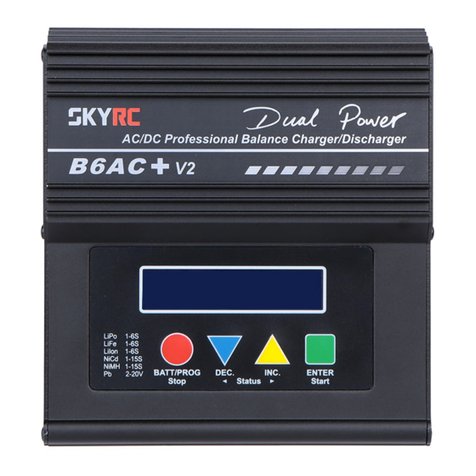
Skyrc
Skyrc B6AC+ DUAL POWER User manual

Skyrc
Skyrc PC1500 User manual

Skyrc
Skyrc e6 sk-100052 User manual

Skyrc
Skyrc e3 User manual
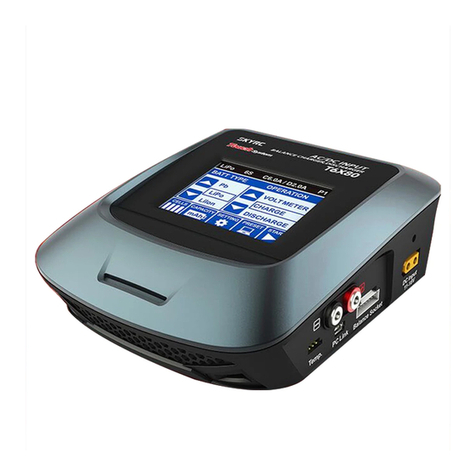
Skyrc
Skyrc T6755 User manual

Skyrc
Skyrc S60 User manual

Skyrc
Skyrc eN18 NiMH User manual
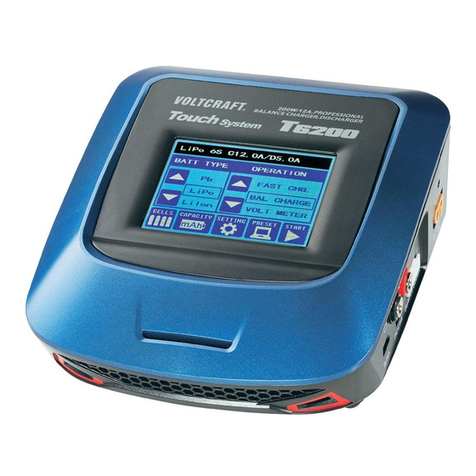
Skyrc
Skyrc T6200 User manual
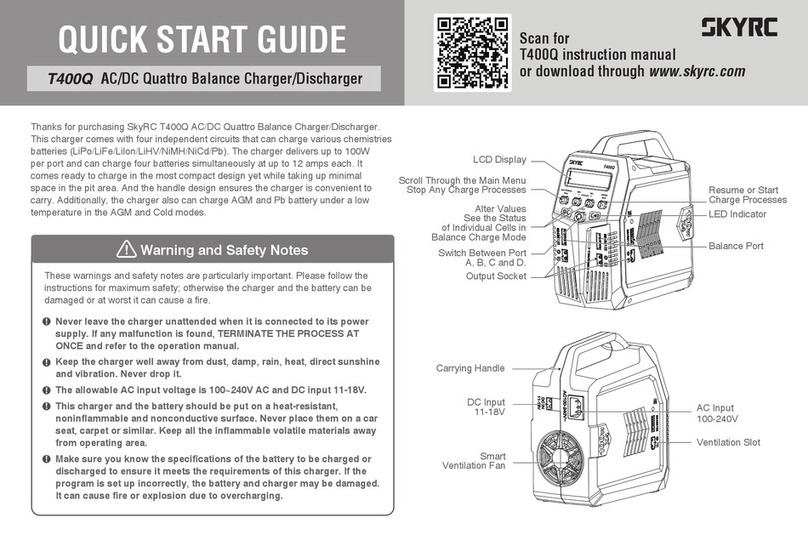
Skyrc
Skyrc T400Q User manual
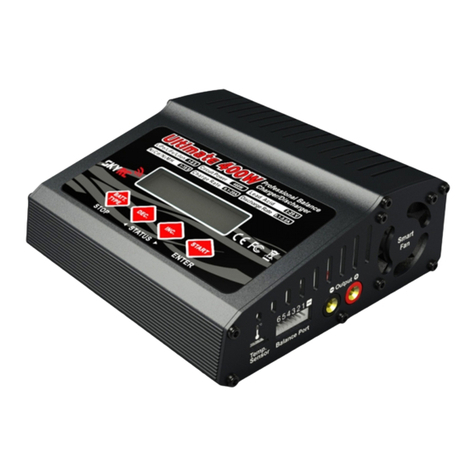
Skyrc
Skyrc Ultimate 400W 20AMP User manual
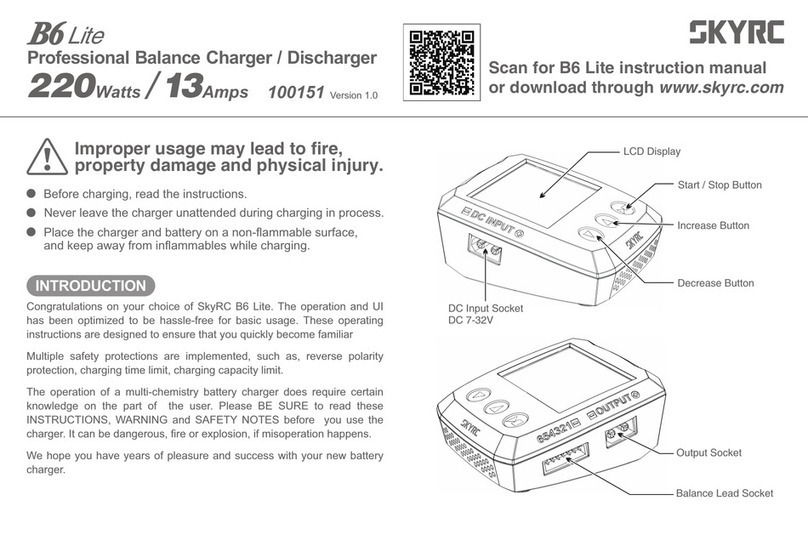
Skyrc
Skyrc B6 Lite User manual
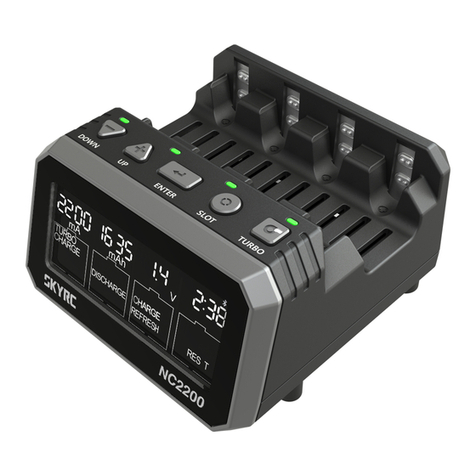
Skyrc
Skyrc NC2200 User manual
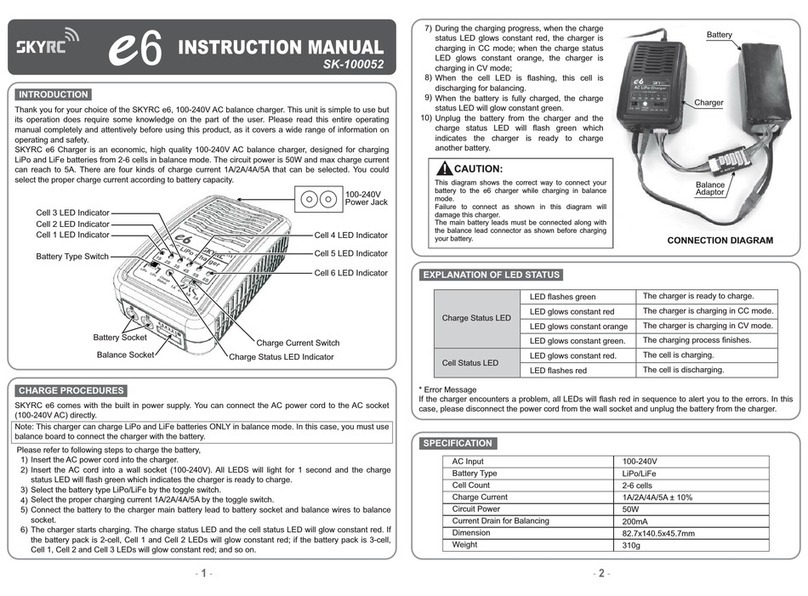
Skyrc
Skyrc e6 SK-100052 User manual
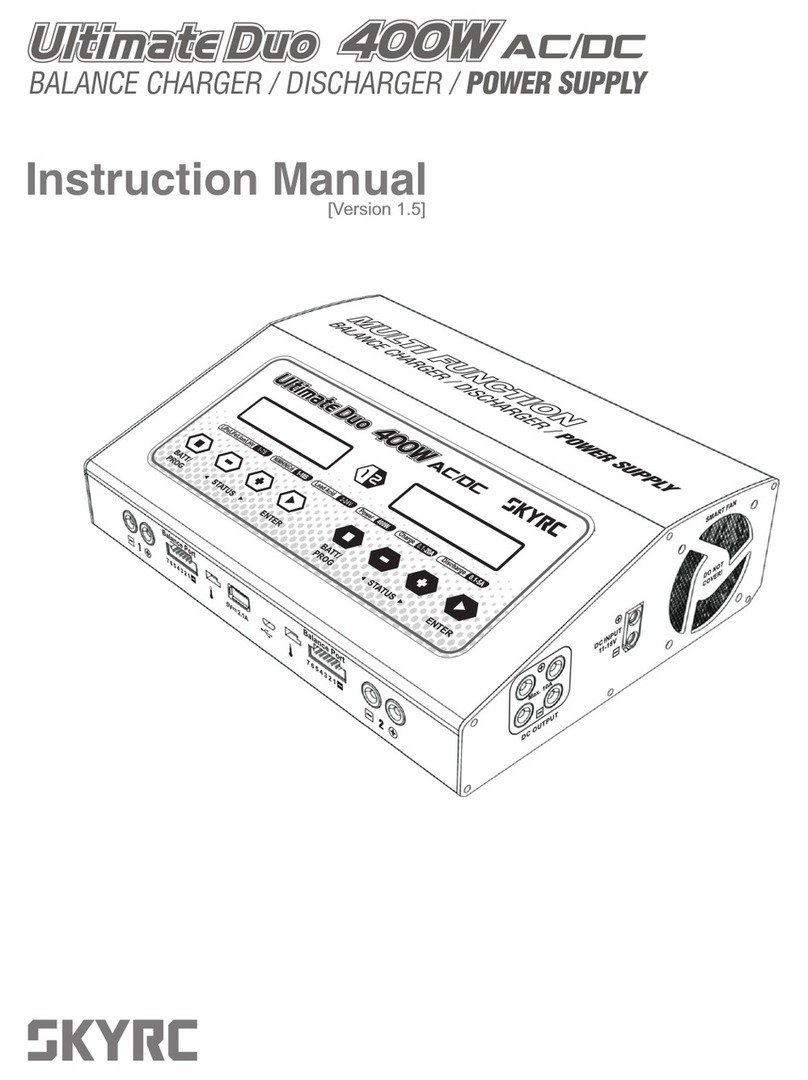
Skyrc
Skyrc Ultimate Duo 400W AC/DC User manual
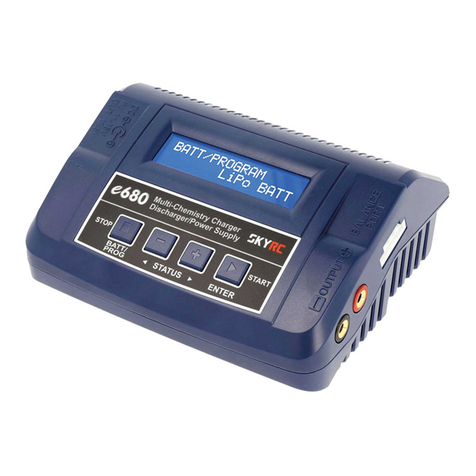
Skyrc
Skyrc e680 User manual

Skyrc
Skyrc SK-100051 User manual
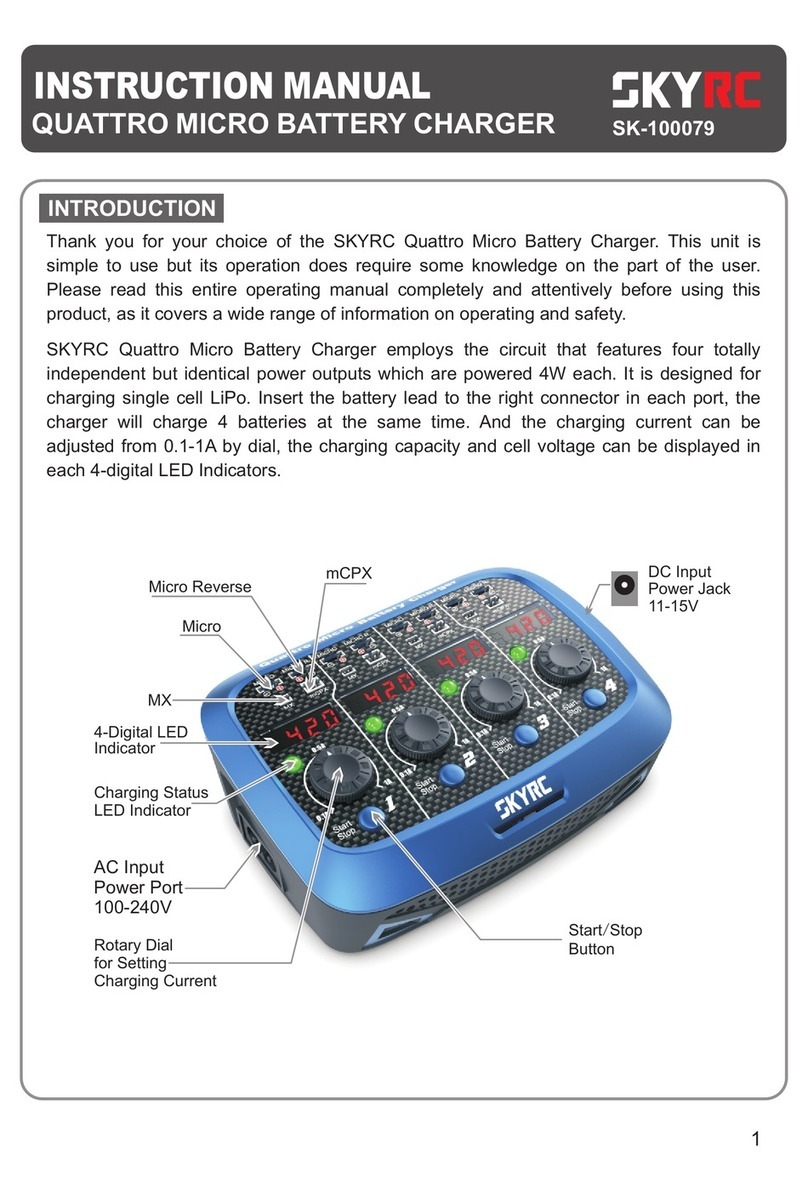
Skyrc
Skyrc SK-100079 User manual
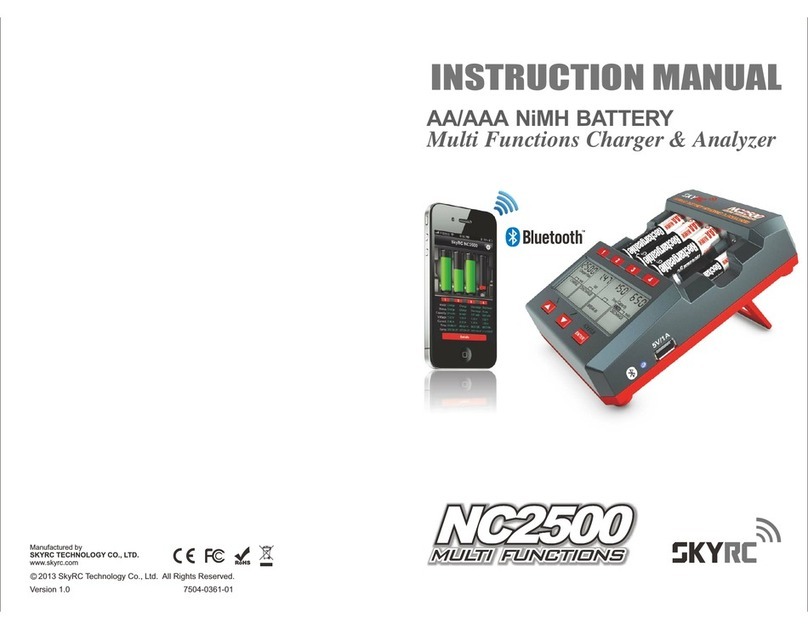
Skyrc
Skyrc NC2500 User manual

Skyrc
Skyrc NC2500 User manual
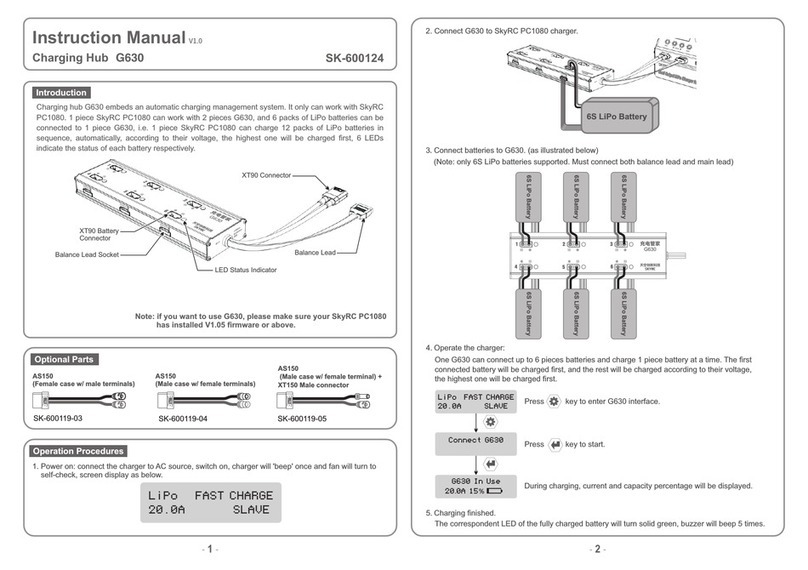
Skyrc
Skyrc G630 User manual
